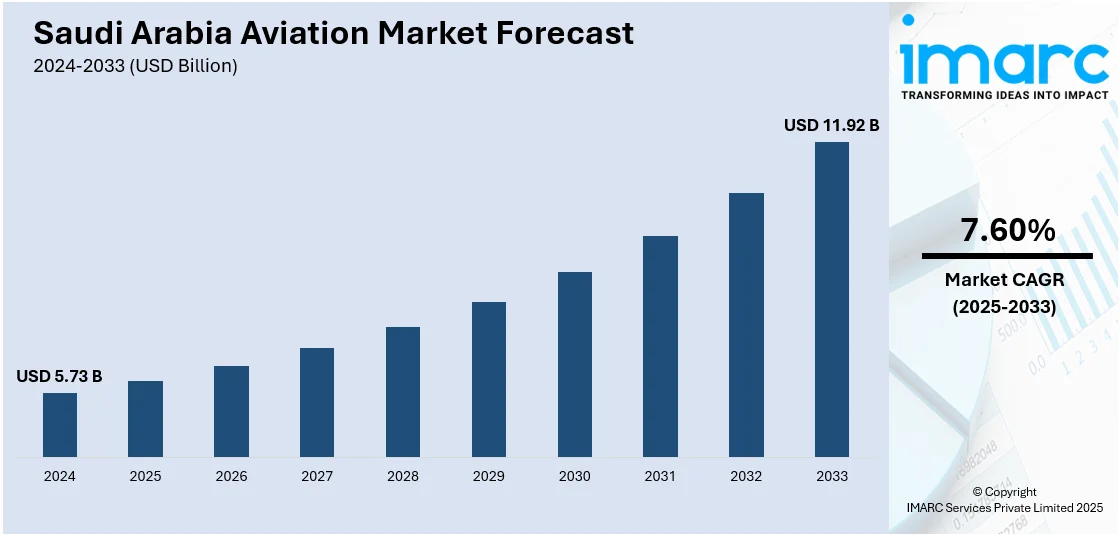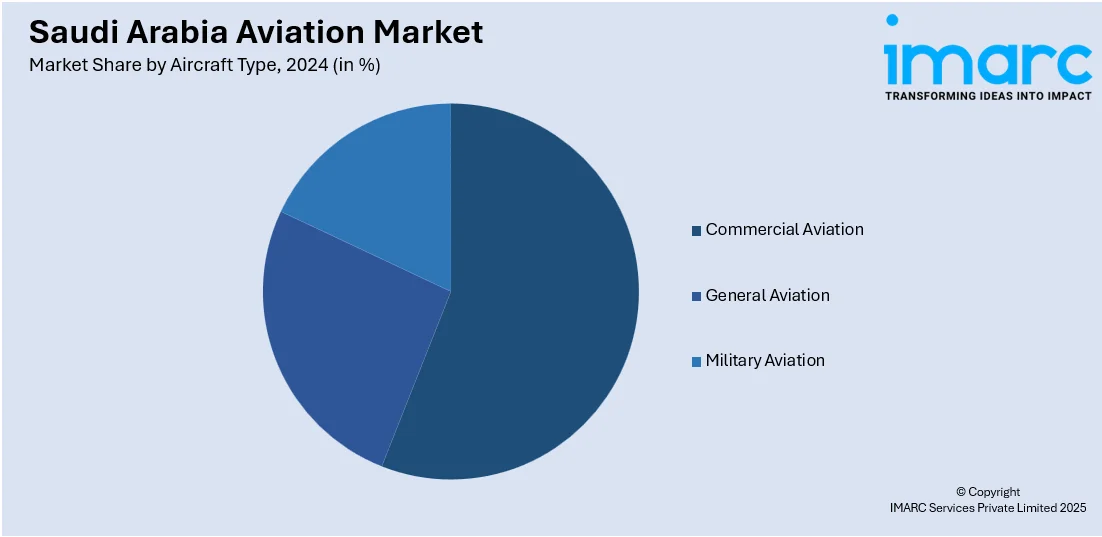
Saudi Arabia Aviation Market Size, Share, Trends and Forecast by Aircraft Type and Region, 2025-2033
Saudi Arabia Aviation Market Overview:
The Saudi Arabia aviation market size reached USD 5.73 Billion in 2024. Looking forward, IMARC Group expects the market to reach USD 11.92 Billion by 2033, exhibiting a growth rate (CAGR) of 7.60% during 2025-2033. The market is driven by national reforms under Vision 2030 and government-backed aviation expansion. Also, major airport projects and infrastructure investment are fueling the product adoption. Additionally, rising tourism and religious travel demand are reshaping airline operations. Policy-led transformation, increased passenger targets, and tourism-driven route development are some of the other factors positively impacting the Saudi Arabia aviation market share.
|
Report Attribute
|
Key Statistics
|
|---|---|
|
Base Year
|
2024 |
|
Forecast Years
|
2025-2033
|
|
Historical Years
|
2019-2024
|
| Market Size in 2024 | USD 5.73 Billion |
| Market Forecast in 2033 | USD 11.92 Billion |
| Market Growth Rate 2025-2033 | 7.60% |
Saudi Arabia Aviation Market Trends:
National Vision 2030 and Strategic Aviation Reforms
Saudi Arabia’s aviation sector is undergoing fundamental transformation under Vision 2030, which positions air transport as a central pillar of economic diversification. The government aims to turn the Kingdom into a global logistics and tourism hub, with an ambitious target of increasing annual passenger traffic by over 300 million. This strategy includes the establishment of a new national airline, Riyadh Air, intended to complement Saudia and compete with regional carriers. On May 9, 2025, IATA announced new training partnerships in Saudi Arabia to prepare over 1,000 local aviation professionals and graduates for roles in airport development, safety, and airline operations. Riyadh Airports Co., Qassim University, and Saudi Academy of Civil Aviation will deliver more than 60 certified courses, while Riyadh Air and Saudia will run talent programs for Saudi nationals, and Saudi Logistics Services (SAL) and Saudi Ground Services (SGS) received advanced training certifications. These initiatives directly support Saudi Arabia’s Vision 2030, targeting 300 million annual air passengers by 2030, with the aviation sector already contributing USD 90.6 billion (8.5% of GDP) and employing 1.4 million people. Regulatory bodies such as the General Authority of Civil Aviation (GACA) are aligning frameworks to support increased competition, private sector participation, and safety modernization. Major investments in air traffic management systems, digital airport operations, and streamlined visa procedures are making Saudi Arabia more accessible to global travelers. As international business and leisure travel become central to the country’s non-oil economy, airlines are scaling operations, ordering new aircraft, and expanding their networks. This broad strategic direction is a primary factor driving Saudi Arabia aviation market growth, particularly as the Kingdom shifts from being primarily an origin-and-destination market to a transfer and hub-focused aviation center. Policy continuity and government funding are enabling faster rollout of airline and airport projects aligned with long-term passenger and cargo growth targets.

Tourism and Religious Travel Demand
Tourism is becoming one of Saudi Arabia’s most active economic sectors, with the country targeting around 100 million annual visitors by 2030. This includes leisure tourism, heritage travel, and a strong focus on religious tourism, particularly Umrah and Hajj. The Kingdom has streamlined visa processes, launched the eVisa platform, and allowed for year-round Umrah visits, increasing flexibility for international pilgrims. Airlines are expanding seasonal and year-round routes to cities like Jeddah and Medina to cater to rising religious travel demand. On April 29, 2025, Saudi Arabia reported that air arrivals in July 2024 were 73% higher than in the same month of 2019, highlighting the country's rise as a global travel hub and reinforcing aviation's role in its economic diversification. The PIF-backed King Salman International Airport is set to handle 120 million passengers annually by 2030 and 185 million by 2050, while Riyadh Air, targeting 100 international destinations, will begin operations in 2025 with established partnerships including Delta Air Lines and Singapore Airlines. New tourism destinations under development, such as NEOM, AlUla, and the Red Sea Project, are generating additional aviation requirements, prompting the creation of dedicated airport facilities and airline partnerships. Both domestic and international carriers are capitalizing on this traffic, launching direct services from Europe, Asia, and Africa. The tourism ministry’s global campaigns, combined with airline and hospitality sector incentives, are increasing Saudi Arabia’s visibility as a destination. As religious and leisure tourism become major contributors to GDP, they are directly influencing airline route planning, fleet expansion, and regional airport utilization, adding further momentum to domestic and international flight operations.
Saudi Arabia Aviation Market Segmentation:
IMARC Group provides an analysis of the key trends in each segment of the market, along with forecasts at the country and regional levels for 2025-2033. Our report has categorized the market based on aircraft type.
Aircraft Type Insights:

- Commercial Aviation
- General Aviation
- Military Aviation
The report has provided a detailed breakup and analysis of the market based on the aircraft type. This includes commercial aviation, general aviation, and military aviation.
Regional Insights:
- Northern and Central Region
- Western Region
- Eastern Region
- Southern Region
The report has also provided a comprehensive analysis of all major regional markets. This includes Northern and Central Region, Western Region, Eastern Region, and Southern Region.
Competitive Landscape:
The market research report has also provided a comprehensive analysis of the competitive landscape. Competitive analysis such as market structure, key player positioning, top winning strategies, competitive dashboard, and company evaluation quadrant has been covered in the report. Also, detailed profiles of all major companies have been provided.
Saudi Arabia Aviation Market News:
- May 11, 2025: RX has announced the launch of inter aviation Arabia, a new aviation trade fair to be held in Riyadh in February 2026, aimed at supporting Saudi Arabia’s transformation into a global aviation and logistics hub. The event will align with the Kingdom’s strategy to handle 330 million passengers annually by 2030 and attract investments across airport infrastructure, equipment, and route development. Backed by RX’s global experience, the platform is expected to drive industry engagement and highlight Saudi Arabia’s central role in regional aviation growth.
Saudi Arabia Aviation Market Report Coverage:
| Report Features | Details |
|---|---|
| Base Year of the Analysis | 2024 |
| Historical Period | 2019-2024 |
| Forecast Period | 2025-2033 |
| Units | Billion USD |
| Scope of the Report |
Exploration of Historical Trends and Market Outlook, Industry Catalysts and Challenges, Segment-Wise Historical and Future Market Assessment:
|
| Aircraft Types Covered | Commercial Aviation, General Aviation, Military Aviation |
| Regions Covered | Northern and Central Region, Western Region, Eastern Region, Southern Region |
| Customization Scope | 10% Free Customization |
| Post-Sale Analyst Support | 10-12 Weeks |
| Delivery Format | PDF and Excel through Email (We can also provide the editable version of the report in PPT/Word format on special request) |
Key Questions Answered in This Report:
- How has the Saudi Arabia aviation market performed so far and how will it perform in the coming years?
- What is the breakup of the Saudi Arabia aviation market on the basis of aircraft type?
- What is the breakup of the Saudi Arabia aviation market on the basis of region?
- What are the various stages in the value chain of the Saudi Arabia aviation market?
- What are the key driving factors and challenges in the Saudi Arabia aviation market?
- What is the structure of the Saudi Arabia aviation market and who are the key players?
- What is the degree of competition in the Saudi Arabia aviation market?
Key Benefits for Stakeholders:
- IMARC’s industry report offers a comprehensive quantitative analysis of various market segments, historical and current market trends, market forecasts, and dynamics of the Saudi Arabia aviation market from 2019-2033.
- The research report provides the latest information on the market drivers, challenges, and opportunities in the Saudi Arabia aviation market.
- Porter's five forces analysis assist stakeholders in assessing the impact of new entrants, competitive rivalry, supplier power, buyer power, and the threat of substitution. It helps stakeholders to analyze the level of competition within the Saudi Arabia aviation industry and its attractiveness.
- Competitive landscape allows stakeholders to understand their competitive environment and provides an insight into the current positions of key players in the market.
Need more help?
- Speak to our experienced analysts for insights on the current market scenarios.
- Include additional segments and countries to customize the report as per your requirement.
- Gain an unparalleled competitive advantage in your domain by understanding how to utilize the report and positively impacting your operations and revenue.
- For further assistance, please connect with our analysts.
 Request Customization
Request Customization
 Speak to an Analyst
Speak to an Analyst
 Request Brochure
Request Brochure
 Inquire Before Buying
Inquire Before Buying




.webp)




.webp)












